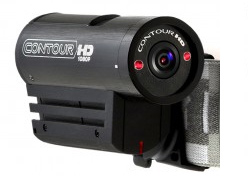Helmet cams are terrific for backcountry skiing. They are small and light, and you can get cool footage with minimal hassle. I’ve tried numerous helmet cams in the past few years, and they have all had various pros and cons. Along with the fun of getting POV adventure shots, I’ve had the frustration of lenses that are too tight, exposure compensation that doesn’t work, difficulty of basic things such as turning the camera on and off… Yep, POV helmet cams run the gamut from fine to frustrating.
The Countour HD is well made, the black brushed aluminum housing feels sturdy. As is essential for outdoor use, it is dust, water and shock resistant, uses a mini-sd card, and receives its juice from a proprietary rechargeable lithium ion battery. The camera has a 135 degree wide angle lens, and shoots in 1080 p high definition.
Contour HD powder skiing from Louie Dawson on Vimeo.
Backcountry powder skiing near Whistler, filmed with the contour hd helmet cam.
A few features make the Contour HD stand out from others. The lens rotates within the camera, so if it is not mounted at the right angle, a simple twist of the lens levels the image. On either side of the lens are two laser pointers, which serve both to make sure the camera is pointed in the right direction, and tell you if it is on. Making sure a helmet cam is pointing the right direction is always a pain — I usually use trial and error to find a position that works. The lasers make it much easier to get the angle right on the first try. They turn on when you press a button on the back, and stay on for a few seconds so you can adjust the position. They also provide some sci-fi like entertainment while your waiting for your buddies to catch up. The record switch is a large slider on the top of the camera. It can be operated with gloves, and a quick feel lets you know if your in recording mode or not.

Contour HD helmet cam for backcountry skiing.
On the back is a small switch that allows you two toggle between two video modes that you can preset in the included software. I found this feature to be truly useful. For most of the helmet cam footage, I wanted the camera to be set to the widest angle, which unfortunately won’t work with full HD, so I set one setting to that. The other position I set to be full HD and not as wide an angle, so I could use the camera as a handheld camcorder.
Included with the camera is software that allows you to easily get clips of the camera and edit and share them. It also is how you adjust some of the settings on the camera, such as exposure compensation. I only used the software for downloading the clips and editing out some of the unusable sections, and still used Adobe Premier for the real editing since most helmet cam software simply does not provide the options of a full-on video editing suite such as Premier or Final Cut.
Before the snow arrived here in the PNW, I took the Contour HD mountain biking a few times on Galbraith mountain, above Bellingham. Both times it was raining hard, and by the end me, my bike, and the Countour HD looked like a chocolate Easter bunny. All that mud was a pretty good torture test in terms of dust and water resistance. Some of the cam’s buttons still felt a little gritty, but everything still works fine. The dark timber didn’t lend itself to filming, and all the shots were too dark to use. The second trip I slid the exposure adjustment to the limit, but it still only got a few seconds of usable footage. I’m not sure what was going on with that (perhaps I missed something), but can conclude that this camera is not exactly intuitive when it comes to getting action footage in lower light conditions.
Next I used the Contour HD while getting some early season turns on Skyline Divide near Mt. Baker. I accidentally left the exposure turned up from mountain biking, but it still managed to get some okay footage, probably since it was a cloudy day. I used the included goggle strap mount so I could let different people use the camera, rather than using one of the permanent sticky attachments.
Next test was bakcountry skiing at Whistler. I remembered to set the exposure back to normal, and as a result got some nice video of the day. The included video is all from that weekend. The big slider switch worked well, allowing me to quickly stop recording to save battery and memory. The lasers didn’t show up on white snow, but they did on my gloved hand, even in bright sunlight, they worked well for aligning the camera, as well as being a good indicator if the camera was on or not. The battery and memory easily lasted for filming almost every run, and there was still plenty left at the end of the day. Being able to snap the camera onto my helmet and turn it on quickly allowed me to keep up in the mad dash to get more pow.
Filming while backcountry skiing is difficult, and you only have one chance to shoot the cool stuff. Having a simple, reliable helmet cam makes documenting your sweet line even easier. Based on use so far, I’d recommend the Contour HD.
Shop for this and other POV cameras.
Louie Dawson earned his Bachelor Degree in Industrial Design from Western Washington University in 2014. When he’s not skiing Mount Baker or somewhere equally as snowy, he’s thinking about new products to make ski mountaineering more fun and safe.
